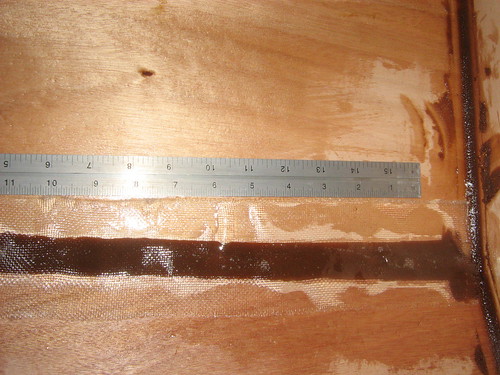Marty,
I hate to say it, but if it were my boat I'd remove the glass tape and try again. There's just too much air and unwetted glass for me to trust that seam. The glare is good, it shows up all the problem spots.
Carefully heating the tape with a heat gun, as Charlie says in the other thread, is probably the best way of removing the tape. It should just pull off with pliers.You may have to hit a few spots with a sander, too, once the boat cools off again. Once the glass is completely gone, you can smooth the fillet and surrounding wood with a light sanding.
Now, to avoid a repeat of the problem, lay out a piece of plastic (the 4 or 6 mil polyethylene dropcloth from the paint section of the local DIY store is perfect) on a flat surface that is long enough to hold the longest piece of tape you need for your boat. A workbench is great, but the floor will do. Cut the glass tape and leave it on the plastic for now.
Apply a very thin coat of very stiff epoxy/woodflour putty to the fillet. The idea is to just fill the dings from the previous attempt. Then, once it sets up a bit but is still soft (maybe 10 minutes), brush it with some unthickened epoxy to completely smooth the surface. It'll end up much smoother than if you'd tried sanding it.
As soon as that's done (don't wait for the epoxy to cure), take your tape and wet it out on the plastic sheet. Use whatever method works for you (I like to just pour the epoxy onto it and work it in with gloved fingers) as long as when you're done the tape is completely transparent and saturated with epoxy. When that's the case, roll up the tape.
Take it over to the boat and unroll it down the fillet. Use your gloved finger or a squeegee (again, I like the gloved finger because of the control it gives me, but others work better with a squeegee) and smooth the tape onto the fillet. Work air bubbles and excess epoxy to the sides.You can scrape the excess epoxy onto the rest of the interior so that it won't be wasted.
This technique is known as wet-on-wet pre-impregnated (pre-preg) glassing among the pros. It has the advantages of needing less time and sanding than waiting for a complete cure between fillets and glassing, as well as separating the wet-out and lay-up operations. This way, unless the wet-out is perfect, you don't proceed to the lay-up and you don't end up with dry, white glass in the seams.
The final thing to remember is that if the tape doesn't look good, pull it up before it cures and try again.
Good luck,
Laszlo
PS - because of all this extra work, you might want to consider ordering a bit more epoxy and woodflour.



